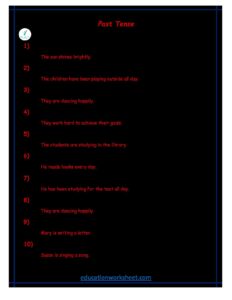how to converting Past Tense interrogative sentences to positive form
how to converting Past Tense interrogative sentences to positive form
Table of Contents
- Introduction
- Importance of Transforming Questions
- Overview of the Conversion Process
- Basic Rules for Converting Past Tense Interrogative Sentences
- Identify the Key Elements
- Remove the Question Word
- Reorder the Sentence
- Converting Past Simple Tense Interrogative Sentences
- Examples and Step-by-Step Guide
- Converting Past Continuous Tense Interrogative Sentences
- Examples and Step-by-Step Guide
- Converting Past Perfect Tense Interrogative Sentences
- Examples and Step-by-Step Guide
- Converting Past Perfect Continuous Tense Interrogative Sentences
- Examples and Step-by-Step Guide
- Advanced Techniques for Complex Sentences
- Handling Embedded Questions
- Dealing with Negative Questions
- Common Mistakes to Avoid
- Subject-Verb Agreement
- Tense Consistency
- Practice Exercises
- Interactive Examples and Quizzes
- Conclusion
- Recap of Key Points
- Importance of Practicing
1. Introduction
Importance of Transforming Questions

Converting past tense interrogative sentences to positive form is crucial for clear and effective communication. While questions are essential for seeking information and engaging in conversations, affirmative statements are often used for reporting facts, providing information, and conveying ideas. Understanding how to make this transformation expands your language toolkit and enables you to express yourself more confidently in various contexts.
Overview of the Conversion Process
The process of converting past tense interrogative sentences to positive form involves a few key steps:
- Identify the Key Elements: Determine the subject, verb, and any additional information in the question.
- Remove the Question Word: In most cases, eliminate the question word (e.g., who, what, when, where, why, how) and any auxiliary verbs.
- Reorder the Sentence: Rearrange the remaining elements to create a clear and concise affirmative statement.
In the following sections, we’ll delve into each step in detail, exploring various past tenses and providing examples to illustrate the conversion process.
2. Basic Rules for Converting Past Tense Interrogative Sentences
Before we dive into specific tenses, let’s establish some basic rules that apply to most past tense interrogative sentences.
Identify the Key Elements
To convert a question into a positive statement, you must first identify the essential elements of the sentence:
- Subject: Who or what the sentence is about.
- Verb: The action or state of being.
- Additional Information: Any adverbs, adjectives, or objects that provide context or detail.
Remove the Question Word
In most cases, the question word (e.g., who, what, when, where, why, how) should be removed when converting to a positive statement.
Reorder the Sentence
Rearrange the remaining elements to form a grammatically correct affirmative statement. Pay attention to subject-verb agreement and tense consistency.
Now, let’s apply these rules to different past tenses.
3. Converting Past Simple Tense Interrogative Sentences

Examples and Step-by-Step Guide
Question: Did she visit the museum?
Step 1 – Identify the Key Elements:
- Subject: she
- Verb: visit
- Additional Information: the museum
Step 2 – Remove the Question Word: Remove “Did.”
Step 3 – Reorder the Sentence: Rearrange the elements: “She visited the museum.”
In past simple tense, the auxiliary verb “did” is removed, and the main verb remains in its base form.
Let’s practice a few more examples:
Question: Did they watch the movie? Positive Form: They watched the movie.
Question: Did he call you yesterday? Positive Form: He called you yesterday.
Question: Did you enjoy the party? Positive Form: You enjoyed the party.
By following the three basic steps, you can convert past simple tense interrogative sentences to positive form effectively.
4. Converting Past Continuous Tense Interrogative Sentences
Examples and Step-by-Step Guide
Question: Was she studying when I called?
Step 1 – Identify the Key Elements:
- Subject: she
- Verb: studying
- Additional Information: when I called
Step 2 – Remove the Question Word: Remove “Was.”
Step 3 – Reorder the Sentence: Rearrange the elements: “She was studying when I called.”
In past continuous tense, the auxiliary verb “was” is removed, and the main verb remains in its -ing form.
Practice with more examples:
Question: Were they playing basketball at that time? Positive Form: They were playing basketball at that time.
Question: Were you working late last night? Positive Form: You were working late last night.
Question: Was he studying for the exam all day? Positive Form: He was studying for the exam all day.
Mastering this conversion process will help you confidently communicate events in the past continuous tense.
5. Converting Past Perfect Tense Interrogative Sentences
Examples and Step-by-Step Guide
Question: Had they finished the project by the deadline?
Step 1 – Identify the Key Elements:
- Subject: they
- Verb: finished
- Additional Information: the project by the deadline
Step 2 – Remove the Question Word: Remove “Had.”
Step 3 – Reorder the Sentence: Rearrange the elements: “They had finished the project by the deadline.”
In past perfect tense, the auxiliary verb “had” is removed, and the main verb remains in its past participle form.
Practice with more examples:
Question: Had she already left when you arrived? Positive Form: She had already left when you arrived.
Question: Had you visited that museum before? Positive Form: You had visited that museum before.
Question: Had he ever traveled to Europe? Positive Form: He had ever traveled to Europe.
Understanding the past perfect tense conversion is valuable for describing events that happened before other past events.
6. Converting Past Perfect Continuous Tense Interrogative Sentences

Examples and Step-by-Step Guide
Question: Had they been working on the project for long?
Step 1 – Identify the Key Elements:
- Subject: they
- Verb: been working
- Additional Information: on the project for long
Step 2 – Remove the Question Word: Remove “Had.”
Step 3 – Reorder the Sentence: Rearrange the elements: “They had been working on the project for long.”
In past perfect continuous tense, the auxiliary verb “had” is removed, and the main verb remains in its -ing form with “been.”
Practice with more examples:
Question: Had she been waiting for you before you called? Positive Form: She had been waiting for you before you called.
Question: Had you been studying for the exam all night? Positive Form: You had been studying for the exam all night.
Question: Had he been practicing the piano for hours? Positive Form: He had been practicing the piano for hours.
Converting past perfect continuous tense interrogative sentences to positive form requires an understanding of both the past perfect and continuous tenses.
7. Advanced Techniques for Complex Sentences
Handling Embedded Questions
Sometimes, past tense interrogative sentences contain embedded questions. To convert these into positive statements, follow these steps:
Question: Do you know if he had arrived? Positive Form: You know he had arrived.
Question: Can you tell me when they were leaving? Positive Form: You can tell me they were leaving.
Dealing with Negative Questions
Negative questions are questions framed with negative words like “didn’t,” “wasn’t,” or “haven’t.” When converting them to positive form, remove the negative element and maintain the question structure:
Question: Didn’t she enjoy the movie? Positive Form: She enjoyed the movie.
Question: Wasn’t he working late last night? Positive Form: He was working late last night.
8. Common Mistakes to Avoid
Subject-Verb Agreement: Ensure that the subject and verb agree in number and person. For example, “He were” should be corrected to “He was.”
Tense Consistency: Maintain consistent tense throughout your sentence. If the original question was in the past tense, ensure that the converted statement remains in the past tense.
9. Practice Exercises
To solidify your understanding, here are some interactive examples and quizzes to test your skills:
- Convert the following past tense interrogative sentences to positive form:
- Did they complete the project on time?
- Were you reading a book when I called?
- Had she already left for work when you woke up?
- Handle embedded questions:
- Convert: Can you tell me if he had visited the museum?
- Convert: Do you know when they were arriving?
- Convert negative questions:
- Convert: Didn’t they enjoy the concert?
- Convert: Wasn’t she playing the piano beautifully?
10. Conclusion
In this comprehensive guide, we’ve explored the process of converting past tense interrogative sentences to positive form. This skill is essential for effective communication and writing in English. By following the basic rules, understanding different past tenses, and practicing with various examples, you can confidently transform questions into affirmative statements. Remember to pay attention to subject-verb agreement, tense consistency, and handle embedded or negative questions appropriately. Continued practice and application of these principles will enhance your language proficiency and help you express yourself clearly and accurately in both spoken and written English.

